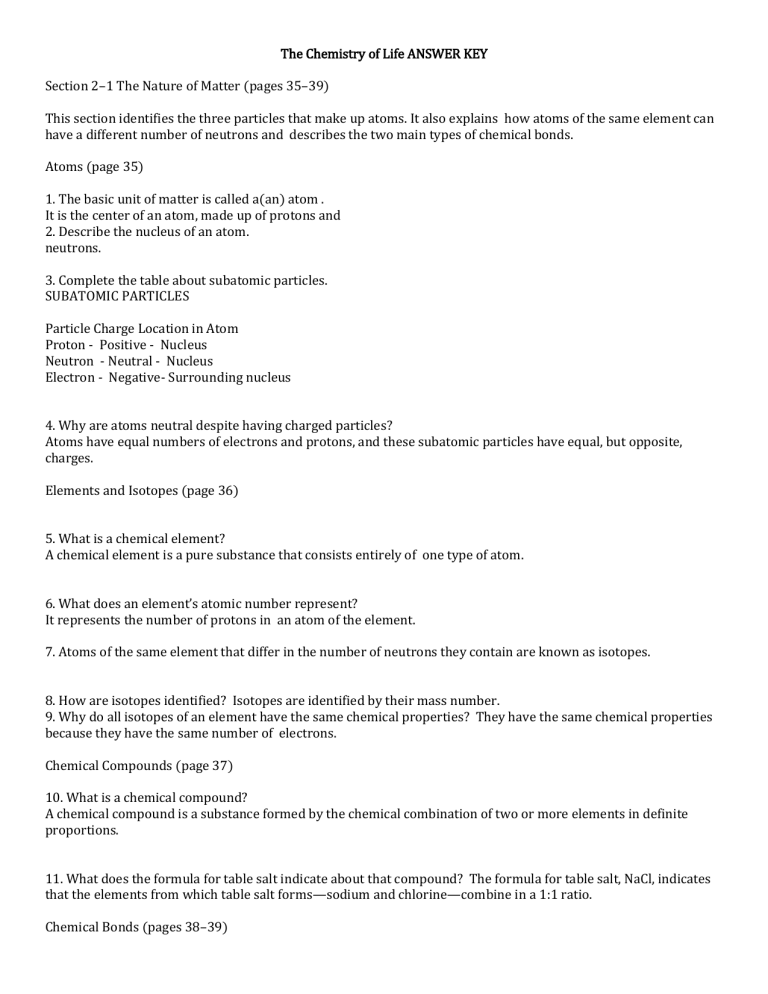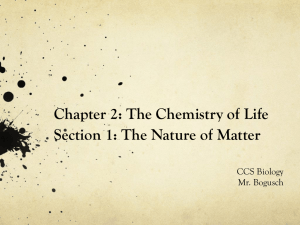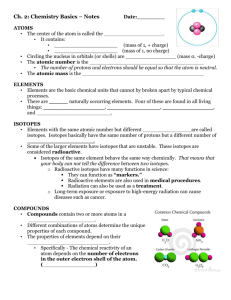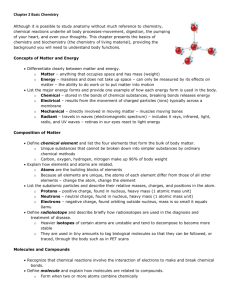The Chemistry of Life ANSWER KEY

The Chemistry of Life ANSWER KEY
Section 2–1 The Nature of Matter (pages 35–39)
This section identifies the three particles that make up atoms. It also explains how atoms of the same element can have a different number of neutrons and describes the two main types of chemical bonds.
Atoms (page 35)
1. The basic unit of matter is called a(an) atom .
It is the center of an atom, made up of protons and
2. Describe the nucleus of an atom. neutrons.
3. Complete the table about subatomic particles.
SUBATOMIC PARTICLES
Particle Charge Location in Atom
Proton - Positive - Nucleus
Neutron - Neutral - Nucleus
Electron - Negative- Surrounding nucleus
4. Why are atoms neutral despite having charged particles?
Atoms have equal numbers of electrons and protons, and these subatomic particles have equal, but opposite, charges.
Elements and Isotopes (page 36)
5. What is a chemical element?
A chemical element is a pure substance that consists entirely of one type of atom.
6. What does an element’s atomic number represent?
It represents the number of protons in an atom of the element.
7. Atoms of the same element that differ in the number of neutrons they contain are known as isotopes.
8. How are isotopes identified? Isotopes are identified by their mass number.
9. Why do all isotopes of an element have the same chemical properties? They have the same chemical properties because they have the same number of electrons.
Chemical Compounds (page 37)
10. What is a chemical compound?
A chemical compound is a substance formed by the chemical combination of two or more elements in definite proportions.
11. What does the formula for table salt indicate about that compound? The formula for table salt, NaCl, indicates that the elements from which table salt forms—sodium and chlorine—combine in a 1:1 ratio.
Chemical Bonds (pages 38–39)
12. What holds atoms in compounds together? Chemical bonds
13. Complete the table about the main types of chemical bonds.
CHEMICAL BONDS
Type Formed when . . .
Covalent bond - Electrons are shared between atoms
Ionic bond - One or more electrons are transferred from one atom to another
14. What is an ion? An ion is an atom that is positively or negatively charged because it has lost or gained electrons.
15. Is the following sentence true or false? An atom that loses electrons has a negative charge.
- false
16. The structure that results when atoms are joined together by covalent bonds is called a(an) molecule
17. Circle the letter of each sentence that is true about covalent bonds. = A, B, D
18. The slight attraction that develops between oppositely charges regions of nearby (polar) molecules are called
Hydrogen bonds.
Section 2–2 Properties of Water (pages 40–43)
This section describes the makeup of water molecules. It also explains what acidic solutions and basic solutions are.
The Water Molecule (pages 40–41)
1. Is the following sentence true or false? A water molecule is neutral. true
2. What results from the oxygen atom being at one end of a water molecule and the hydrogen atoms being at the other end?
The oxygen end of the molecule has a slight negative charge and the hydrogen end has a slight positive charge.
3. Why is a water molecule polar?
There is an uneven distribution of electrons between the oxygen and hydrogen atoms.
4. Circle the letter of each sentence that is true about hydrogen bonds. = B, D (between Molecules!)
5. Complete the table about forms of attraction.
FORMS OF ATTRACTION
Form of Attraction Definition
Cohesion Attraction between molecules of the same substance
Adhesion Attraction between molecules of different substances
6. Why is water extremely cohesive? It is very cohesive because of hydrogen bonding.
7. The rise of water in a narrow tube against the force of gravity is called capillary action
8. How does capillary action affect plants?
Capillary action is one of the forces that draws water out of the roots of a plant and up into its stems and leaves.
Solutions and Suspensions (pages 41–42)
9. What is a mixture?
A mixture is a material composed of two or more elements or compounds that are physically mixed together but not chemically combined.
10. A mixture of two or more substances in which the molecules of the substances are evenly mixed is called a(an) Solution
11. The greatest solvent in the world is water
12. What is a suspension? A suspension is a mixture of water and nondissolved substances that are so small they do not settle out.
13. Complete the table about substances in solutions.
SUBSTANCES IN SOLUTIONS
Substance Definition Saltwater Solution
Solute Substance that is dissolved Table salt
Solvent Substance in which the solute dissolves Water
Acids, Bases, and pH (pages 42–43)
14. Two water molecules can react to form ions
15. Why is water neutral despite the production of hydrogen ions and hydroxide ions? It is neutral because the number of positive hydrogen ions produced is equal to the number of negative hydroxide ions produced.
16. What does the pH scale indicate? It indicates the concentration of H+ ions in solution.
17. On the pH scale below, indicate which direction is increasingly acidic and which is increasingly basic.
Increasingly acidic neutral Increasingly basic
18. How many more H+ ions does a solution with a pH of 4 have than a solution with a pH of 5? 10 times
19. Circle the letter of each sentence that is true about acids. = A, B, D









